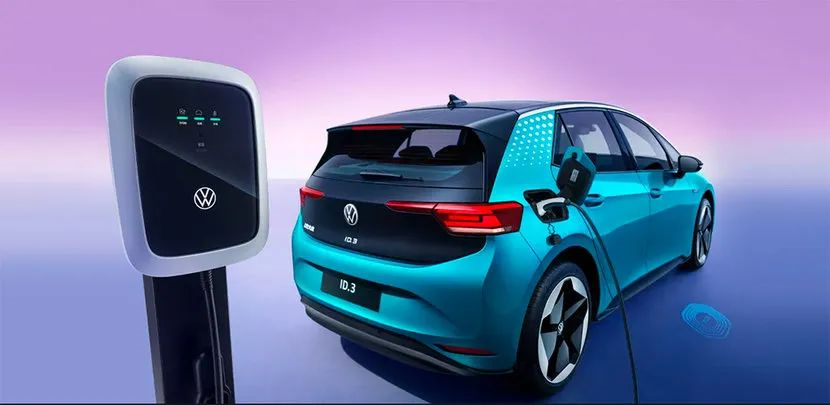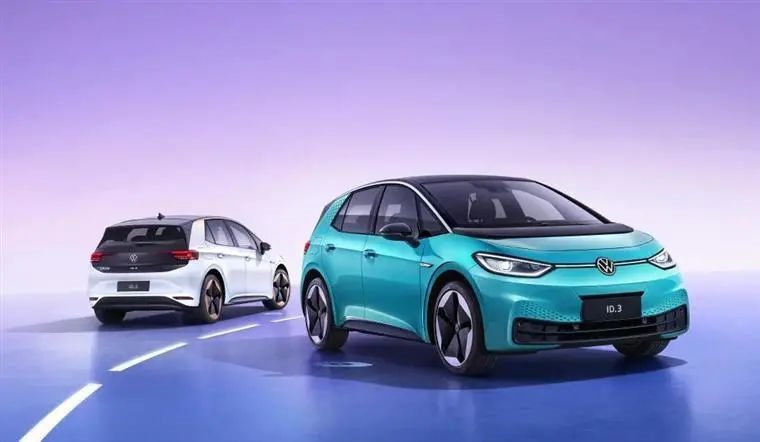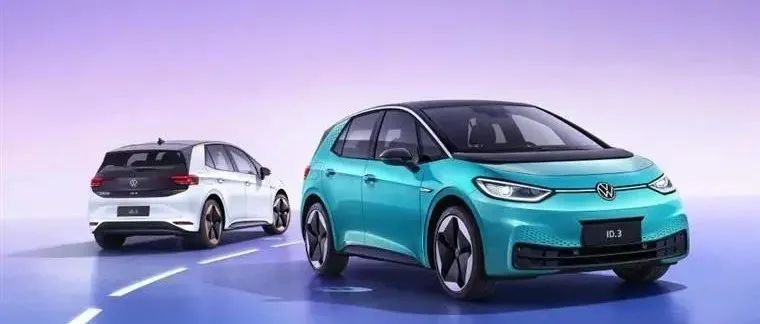Author: Nie Yiyao
Volkswagen’s electrification journey towards China has once again stepped up with the entry of ID.3, a compact pure electric two-door car.
On October 22, ID.3 officially entered the Chinese market under the banner of SAIC Volkswagen. Like ID.4 and ID.6, ID.3 comes from Volkswagen’s MEB pure electric platform and is also the first model of Volkswagen’s MEB platform. However, in Volkswagen’s global electrification campaign, considering the differences in consumer preferences for different models in the Chinese and European markets, ID.3 did not take the lead in China like in the European market. Instead, after the compact pure electric SUV ID.4 and the mid-to-large pure electric SUV ID.6 landed in China, Volkswagen sent its most competitive ID.3 in the European market to “conquer” the Chinese market.
In this way, Volkswagen’s ID. series has formed a product layout of ID.3 + ID.4 + ID.6 in the domestic market, targeting young women or small families + young families + multi-person families, complementing each other. Of course, the lineup of the three products facing the fierce competition in China’s new energy vehicle market cannot be called strong, but considering Volkswagen’s strengthening of the MEB platform layout in the Chinese market (newly added SAIC Volkswagen MEB Changsha factory with an annual production capacity of 100,000 vehicles), the production capacity of Volkswagen’s MEB in the north and south has reached 750,000 vehicles. This is just the beginning.
ID.3 has performed well in the European market, and it was reported by foreign media as the best-selling pure electric car in Europe just one month after its launch. Afterwards, it was hailed as the “King of Electric Vehicles” in the European market. Just on the first anniversary of its launch in Europe in October this year, Volkswagen officially announced its first-year sales performance: it delivered about 70,000 new cars worldwide; at the same time, the total number of orders has exceeded 144,000. According to foreign media reports, ID.3 has been among the top five in monthly sales volume in the European market.
Why can ID.3 make waves in the European market, what are its advantages and external factors?
The positioning of ID.3 has significant significance. After Beetle and Golf, who will continue Volkswagen’s next legend? Perhaps it is ID.3. More mission-oriented than Beetle and Golf, ID.3 will run on a new track different from the previous two, with opportunities and challenges.The ID.3 is based on Volkswagen’s MEB platform, which is a scalable and modular architecture that provides greater flexibility in body and interior design, allowing for more imaginative styling and increased maneuverability. This is crucial in determining the vehicle’s distinctive character, such as its wheelbase – the 2765mm wheelbase gives the ID.3 superior A+ class interior space. The ID.3’s cross-border two-door design also gives it a more lively and personalized character as an electric vehicle, which is well presented.
While the ADAS and electrical systems of the ID.3 may not be advanced, they are supplied by the same vendors as the Golf 8 in most cases, making the ID.3 mature and stable in these aspects. For example, the front-facing camera for the forward collision warning system uses the latest generation of front-facing camera boards from Valeo, sensors from Hella and microcontrollers from Renesas, with sensors that support active arrays with 1280×1080 pixels and a 60 frames per second image output rate. The front radar from Continental, using fifth-generation 77GHz technology, has blind spot monitoring, lane keeping and rear cross traffic alert functions. The four main parts of the ID.3 electrical system are Bosch’s DC/DC converter, Huber Automotive’s battery management system (BMS), Valeo – Siemens’ inverter and Lear’s on-board charger.
The image of an electric Volkswagen Golf and the general preference for “small cars” among European consumers, coupled with the pursuit of “intelligence” and “longer battery life” by Chinese users, has given the ID.3 a rapidly growing market in Europe. It is reported that the starting price of the ID.3 in Europe is 37,000 Euros, equivalent to over 270,000 RMB, demonstrating European consumers’ true love for the ID.3.
In 2020, the European new energy vehicle market surpassed China for the first time due to strong policy impact. Public data shows that the total number of new energy vehicle registrations in Europe in 2020 reached 1.395 million, a year-on-year increase of 137%, while China’s new energy vehicle sales during the same period increased by 12% to 1.337 million.
What kind of market environment will the ID.3 face when entering China?The data shows a significant reversal this year. According to China Association of Automobile Manufacturers (CAAM), the cumulative sales of new energy vehicles (NEVs) in China from January to September 2021 reached 2.157 million units, an increase of 185.3% compared with the same period last year. Among them, the sales of pure electric vehicles (BEVs) were 1.789 million, a growth rate exceeding 200%. Meanwhile, according to the data released by the European Automobile Manufacturers’ Association (ACEA), the new registration of new energy vehicles in Europe exceeded 1.438 million units from January to September 2021. Among them, about 704,000 were BEVs, and 734,000 were plug-in hybrid electric vehicles (PHEVs).
It is evident that under the negative factors of the pandemic and chip shortage, the growth of NEV sales in the European market this year is far behind that of the Chinese market. In addition to overall growth, consumer preferences also determine the different situations of BEVs in the two major markets. As can be seen from the above data, European consumers’ willingness to buy BEVs remains equal to that of PHEVs. This structure has continued for a long time and is estimated to remain unchanged in the short term.
However, the Chinese market is completely different. Not only has the overall increase in NEV been greatly released in the first three quarters of this year, but this release also almost completely stems from the rapid rise in BEV sales. Domestic consumers’ purchase intentions for BEVs have begun to surge, and in this process, the sales of micro and small BEVs have shrunk, replaced by an increase in compact NEVs. In the top 15 NEV models ranked by the China Passenger Car Association (CPCA) from January to September, the proportion of micro and small BEVs has dropped from 47% to 34.5%, while the compact NEVs represented by BYD Qin and Song series have been hot sellers.
Anyway, the strong demand for domestic NEV market led by BEVs is growing rapidly, and the demand for compact NEVs is opening up. Although the market sales of compact NEVs are not fully supported by BEVs at present, A+ grade compact BEVs like ID.3 have seized the good times of the market explosion, and the favorable conditions are in place.
Who are the Competitors of ID.3 in China?
A strong market inevitably has strong opponents. The domestic NEV market is still in the “Warring States Era” with various major brands competing for supremacy. However, the head effect has emerged, and the strong players from the three systems of independent, joint ventures, and new forces are sharing the market, while middle companies are struggling to survive, and the tail companies are either extinct or in danger.In this cruel competition, it remains to be seen whether the ID.3, with its European preferences, can cut a bloody path. One thing for sure is that this is a tough battle. First of all, unlike traditional fuel vehicles, Chinese consumers prefer domestic brands and new forces when it comes to new energy vehicles, and are not as optimistic about joint venture brands.

Secondly, domestic brands have been deeply rooted in the Chinese market for many years and have a good understanding of Chinese consumer preferences. They have made significant contributions in battery life, smart cabins, and driving assistance. New forces are unrestrained in exploring consumer desires, especially in intelligent networking and autonomous driving. In terms of marketing, new forces are also bold and innovative, and domestic brands have learned from them and become proficient in this area.
Thirdly, when it comes to ID.3’s opponents, compact new energy vehicles such as BYD Qin Plus, Aiways AION S, and XPeng P5, as well as Tesla Model 3 (in the European market), they are all difficult opponents.
Some netizens compared the BYD Dolphin with the ID.3, which is not rigorous, as the two cars are not in the same category. ID.3’s first strong opponent is Qin Plus from BYD, which ranked third in new energy vehicle sales in September, following the Hongguang MINI EV and Tesla Model Y. Qin Plus has proven its strength.

Aiways AION S and XPeng P5 also have a significant user base and good reviews. Aiways AION S has monthly sales that can rank top ten, and XPeng P5 was newly launched in September with a target audience of “versatile, comfortable and intelligent family sedan.” Both cars are well-positioned in the young consumer market.
Tesla Model 3, to be honest, ID.3 wins hands down in the European market, but in China, Model 3 should not be considered a competitor to ID.3. Although setting ambitious goals is essential for a brand, ID.3 needs to show its advantages and characteristics, attract its target consumers, and stand out in this highly competitive market, where business can be as challenging as warfare.## Translation
It remains to be seen whether Volkswagen’s electric vehicle penetration strategy in China, named “Dong Zheng,” will be successful with the help of ID.3. However, with Volkswagen’s determination to electrify and SAIC Volkswagen’s many years of experience in the Chinese market with strong reserves in funding, research and development, marketing networks, and the booming trend of new energy vehicle consumption in China, the war waged by ID.3 is expected to be an exciting one.
Markdown
It remains to be seen whether Volkswagen’s electric vehicle penetration strategy in China, named “Dong Zheng,” will be successful with the help of ID.3. However, with Volkswagen’s determination to electrify and SAIC Volkswagen‘s many years of experience in the Chinese market with strong reserves in funding, research and development, marketing networks, and the booming trend of new energy vehicle consumption in China, the war waged by ID.3 is expected to be an exciting one.
This article is a translation by ChatGPT of a Chinese report from 42HOW. If you have any questions about it, please email bd@42how.com.
